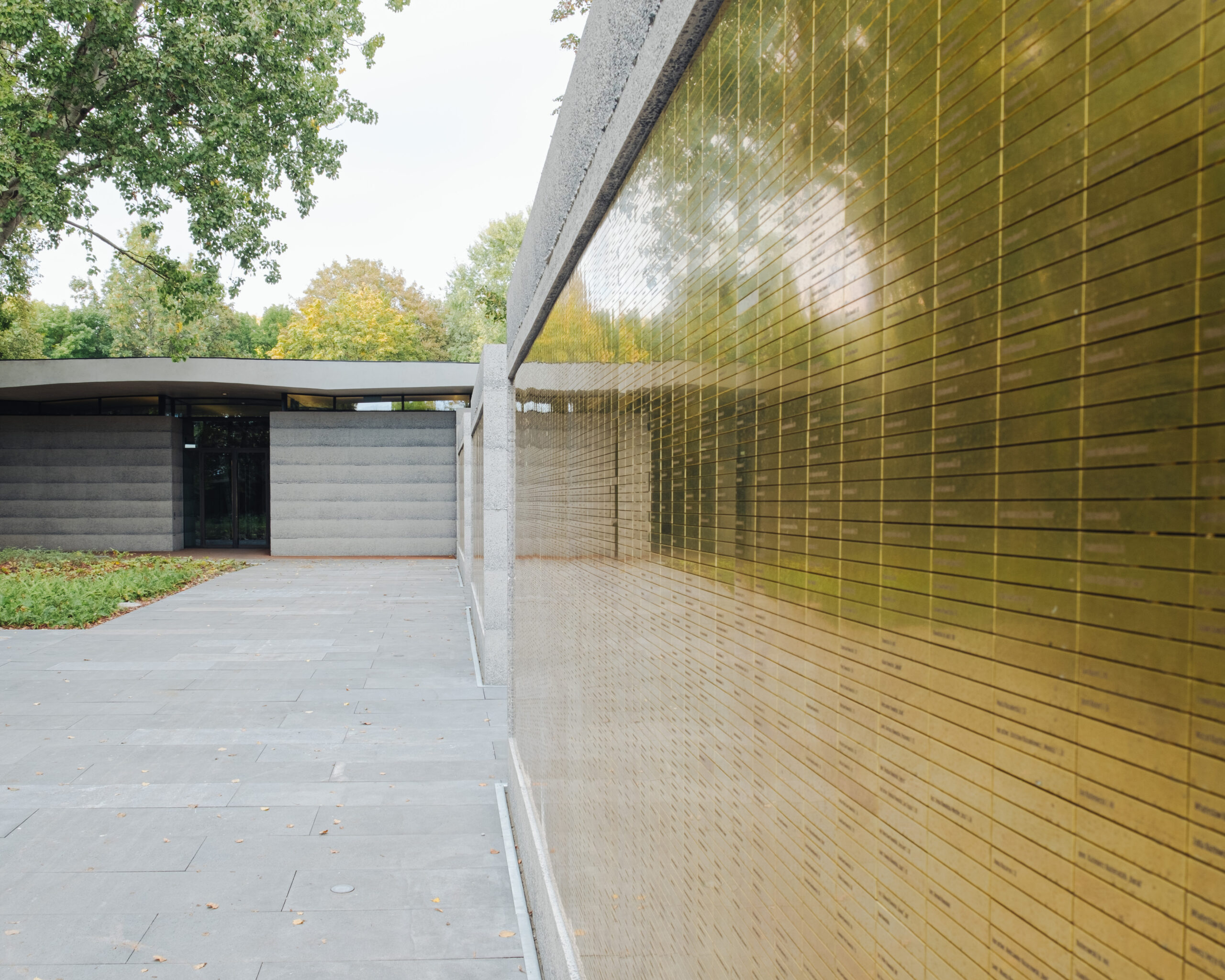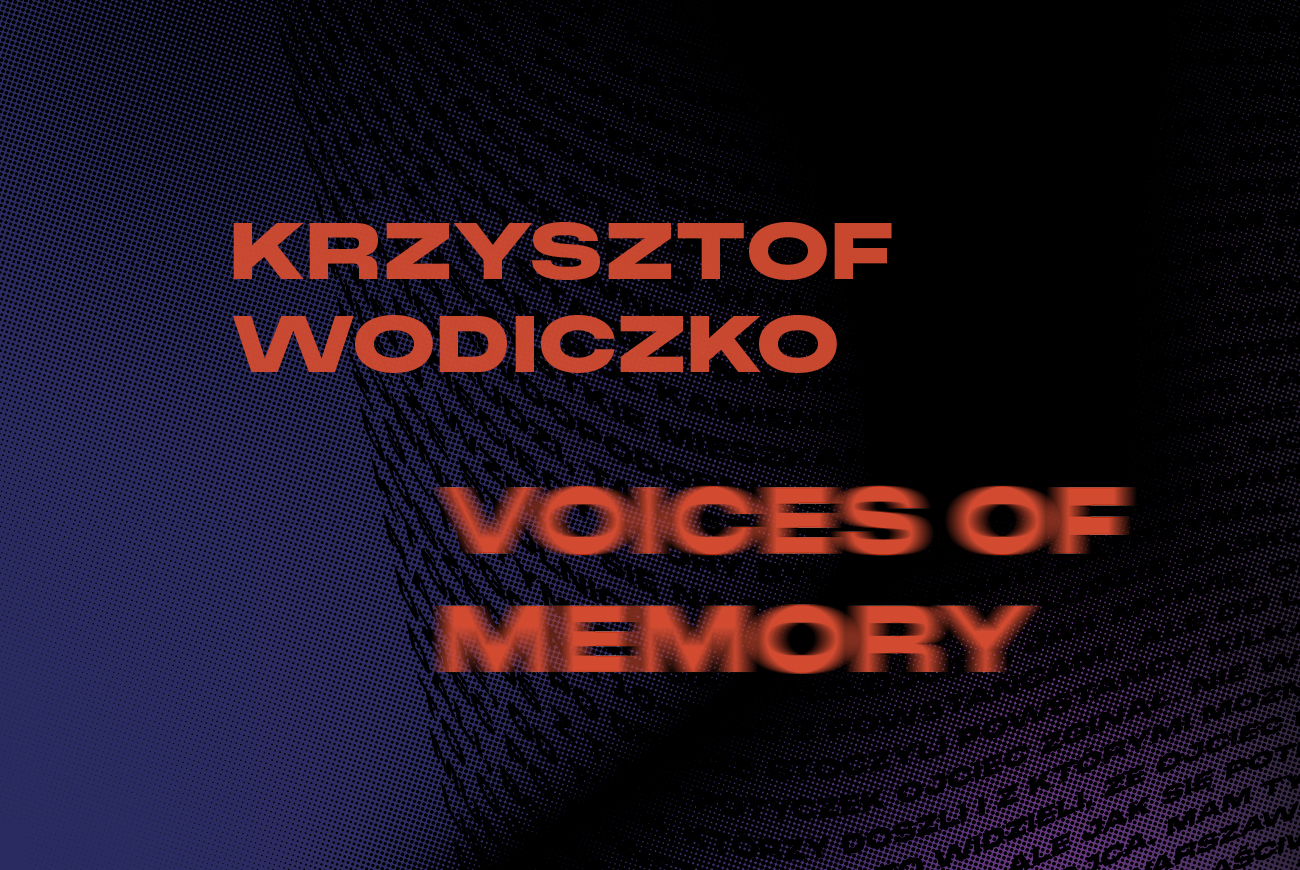Exhibitions at the Hall of Remembrance
The Hall of Remembrance is a place where one can reflect upon the consequences of violence, radicalism and military conflicts. Its mission is to appeal for dialogue and to “call for peace”. The expositions presented at the Hall are aimed to honour the victims of the 1944 Warsaw Uprising and to raise awareness of the importance of the Warsaw Insurgents Cemetery. The names of tens of thousands of victims of the Warsaw Uprising have been rescued from oblivion and are now recorded on the Wall of Remembrance.
Voices of Memory
Read transcripts of recorded memories. Click to open the content in a new page.
A project by Krzysztof Wodiczko, one of the most celebrated Polish artists in the world. Voices of Memory audio-visual installation commemorates the victims of the Warsaw Uprising and tells the tragic stories of the civilian population of Warsaw in 1944.
Krzysztof Wodiczko is one of the most acclaimed audio-visual artists today. The audio-visual installation titled Voices of Memory—focuses on the tragic fate of the civilians in Warsaw, their courage, suffering and aid they provided to the insurgents in 1944. It deals in a deeply moving way with the sacrifice of Warsaw residents, driven out of their homes and murdered in mass executions. Created especially for the permanent exhibition at the Hall of Remembrance, the work is in line with the message of Wodiczko’s oeuvre—for years now, the artist has been engaged in anti-war activities, calling for “the art of un-war” and for establishing the World Institute for the Abolition of War.
Voices of Memory installation is a focal point of the Hall of Remembrance pavilion. The exhibition hall is filled with the accounts of witnesses to the Nazi crimes and of their relatives. Civilians, soldiers as well as the younger generations who carry the burden of the wartime events will be given their voice, among them Wanda Traczyk-Stawska and Tadeusz Rolke. The core of the installation are the testimonies of people affected by the trauma of the Warsaw Uprising. Those personal stories, juxtaposed with one another, form a multi-layered and not-so-obvious portrait of Warsaw in 1944. The witness testimonies are accompanied by the images of flames, propelled by the sound of human voice.
The Voices of Memory project has been realised in cooperation with the Profile Foundation and the Embassy of Germany. The exhibition is financed by the City of Warsaw and the German Ministry of Foreign Affairs. The Mayor of Warsaw is an honorary patron of the project.
Wartime stories and experiences in conversation with Krzysztof Wodiczko were shared by:
- Bohdan Bartnikowski,
- Helena Bułgarska,
- Elżbieta Gutowska-Niedziałek,
- Tomasz Karasiński,
- Wiesław Kępiński,
- Elżbieta Leszczyńska,
- Monika Lurie,
- Stanisław Maliszewski,
- Stefan Niesłuchowski,
- Tadeusz Rolke,
- Łucjan Sokołowski,
- Jadwiga Szczęścik-Parucka,
- Krzysztof Szlifirski
- and Wanda Traczyk-Stawska.
WARNING! Due to the difficult content presented in the exhibition, we request that children under the age of 14 view the installation accompanied by an adult.
COLOPHON
Conceived, written and directed by Krzysztof Wodiczko
Initiator of the project Jarosław Trybuś
Produced by Muzeum Warszawy
Associate producer Fundacja Profile
Executive producer Bożena Czubak
Interface development Jerzy Stypułkowski
Director of photography and camera operator Marcin Hiller
Sound postproduction Grzegorz Kucharski
Editor Łukasz Gregorek
Implementation Eidotech Polska
Project coordinators Olga Baron i Marta Galewska
Design: Joanna Bębenek

THE HALL OF HISTORY
Historical exhibition
The exhibition retells the story of postwar efforts made towards the establishment of the Warsaw Insurgents Cemetery. The story begins right after the Warsaw Uprising. The photographs of the capital city taken after the fighting had stopped in 1944 show the scale of destruction—a city turned into ruins and graves scattered across the rubble.
The story of striving to commemorate the victims of the 1944 Uprising has been divided into four thematic fields: Exhumations (1945-1947); Establishing the Cemetery of the Fallen in the Uprising (from November 1945 until the early 1950s, i.e. as long as the burials were taking place); Erasing from Memory (1950s-1980s) and Rescuing from Oblivion (1990s till 2022).
The last thematic field presents social actions undertaken with the aim to restore the cemetery to its proper rank. The informal Social Committee for the Insurgents Cemetery, set up in the 1990s, carried out, among others, an operation of collecting the names of the fallen, of those who had died or disappeared during the Uprising, with the aim to put them on the Wall of Remembrance. Thanks to the Committee’s efforts a stone altar was erected in 2004, sacral and insurgent symbols were incorporated in the Fallen Invincible monument (2001) and on the tombstones (from 2012), the cemetery was entered in the Historic Monuments Register (2012) and a competition for the Hall of Remembrance architectural concept was launched (2014).
Each of the themes is illustrated by scans of photographs, documents, press cuttings from the Museum of Warsaw collection and from archival research (footnote 1).

A scan of the book of the people buried at the cemetery is a vital element of this section of the exhibition. The book contains entries dating back to 30 November 1945 until 1957, as well as singular, incidental entries from the later period. The last entry dates back to 21 June 2001. Over 320 pages of the book are filled mainly with the abbreviation “N.U.” [name unknown] entered in the first name and surname column—and this is perhaps the most poignant testament to the tragedy of the Uprising.
The exhibition closes with a film which conveys the message of Wanda Traczyk-Stawska, prime mover behind the construction of the Hall of Remembrance and the chair of the Committee, addressed to the future generations.
The Room also houses a sculpture by Gustaw Zemły titled “The Reclining One”, from the Reclining Figures series. The cast in bronze dates back to 1967 and is a draft for the Fallen Invincible 1939-1945 monument unveiled at the Warsaw Insurgents Cemetery in 1973.
The Wall of Remembrance
The Wall of Memory, situated outside along both sides of the building, is an integral part of the Hall of Remembrance. It bears engraved plaques with the names of nearly 62,000 individuals—identified civilian victims and soldiers of the Warsaw Uprising. The list is being created on the basis of data collected by the Warsaw Rising Museum and as a result of the activities of the Warsaw Insurgents Cemetery Social Committee. The project of the Wall envisages adding more plaques whenever more people are identified.

FOOTNOTE 1: The research was conducted at the Institute of National Remembrance, the State Archives in Warsaw, the Warsaw Rising Museum, the Dulag 121 Museum, the National Film Archive – Audiovisual Institute, Voivode’s Deputy for the War Veterans and the Repressed, the Polish Red Cross, and with materials collected by the Warsaw Insurgents Cemetery Social Committee.



